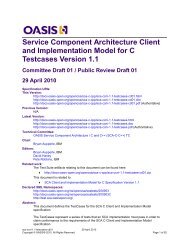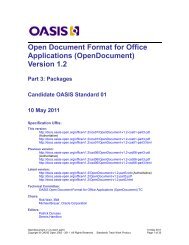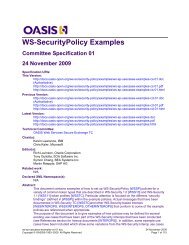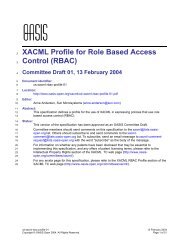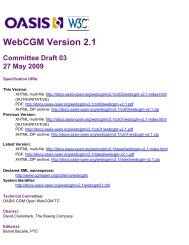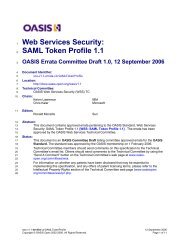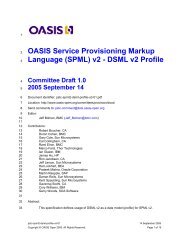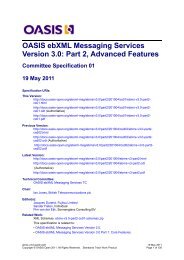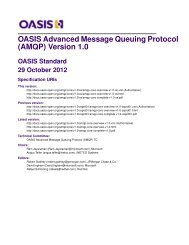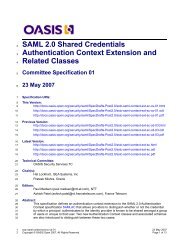Content Management Interoperability Services (CMIS) Version 1.1
Content Management Interoperability Services (CMIS) Version 1.1
Content Management Interoperability Services (CMIS) Version 1.1
Create successful ePaper yourself
Turn your PDF publications into a flip-book with our unique Google optimized e-Paper software.
2.1.6 Relationship Object<br />
A relationship object is semantically a dependent object. A relationship object MUST NOT have a content<br />
stream, and MUST NOT be versionable, MAY be queryable, and MUST NOT be fileable, although it MAY<br />
be controllable.<br />
If a repository does not support relationship objects, the relationship base object-type SHOULD NOT be<br />
returned by a getTypeChildren service call.<br />
A relationship object instantiates an explicit, binary, directional, non-invasive, and typed relationship between<br />
a source object and a target object. The source object and the target object MUST both be independent<br />
objects, such as a document object, a folder object, a policy object, or an item object. Whether a policy<br />
object is allowed to be the source or target object of a relationship object is repository-specific.<br />
The relationship instantiated by a relationship object is explicit since it is explicitly represented by an object<br />
and is explicitly managed by application.<br />
This relationship is non-invasive in the sense that creating or removing this relationship SHOULD NOT<br />
modify either the source or the target object. That is, it SHOULD NOT require an update capability (or<br />
permission) on either object; SHOULD NOT affect the versioning state of either object; and SHOULD NOT<br />
change their "Last Modification Date".<br />
Explicit relationships can be used to create an arbitrary relationship graph among independent objects.<br />
Such a relationship graph is only structural in nature. No inheritance or transitive properties are attached to<br />
a relationship graph.<br />
The notion of a source object and a target object of a relationship is used solely to indicate the direction of<br />
the relationship. No semantics or implementation bias is implied by this terminology.<br />
The binding of a relationship object to a source document object or to a target document object MAY be<br />
either version-specific or version-independent. This version sensitivity is repository-specific, and is largely<br />
transparent to <strong>CMIS</strong>. An independent object MAY participate in any number of explicit relationships, as the<br />
source object for some and as the target object for others. Multiple relationships MAY exist between the<br />
same pair of source and target objects.<br />
Referential integrity, either between the source object and the target object, or between the relationship<br />
object and the source or target object, is repository-specific. Therefore, creating an explicit relationship<br />
between two objects MAY impose a constraint on any of the three objects, and removing a relationship or<br />
deleting either the source or the target object MAY be restricted by such a constraint. If the source or the<br />
target object of a relationship is deleted, the repository MAY automatically delete the relationship object.<br />
Like all <strong>CMIS</strong> objects, relationship objects are typed. Typing relationship allows them to be grouped, identified,<br />
and traversed by type id, and for properties to be defined for individual relationship types.<br />
Additionally, a relationship object-type MAY specify that only objects of a specific object-type can participate<br />
as the source object or target object for relationship objects of that type. If no such constraints are specified,<br />
then an independent object of any type MAY be the source or the target of a relationship object of that type.<br />
When a relationship object is created, the source object id and the target object id MUST reference valid<br />
non-relationship <strong>CMIS</strong> objects. When a relationship object is retrieved, its source object or target object<br />
MAY no longer exist, since referential integrity MAY not be maintained by a repository.<br />
In addition to object CRUD services, a getObjectRelationships service may be used to return a set<br />
of relationship objects in which a given independent object is identified as the source or the target object,<br />
according to the binding semantics maintained by the repository (i.e., either a version-specific or a versionindependent<br />
binding as described above).<br />
2.1.6.1 Relationship Object-Type Definition<br />
This section describes the definition of the relationship object-type's attribute values and property definitions<br />
which must be present on relationship instance objects. All attributes and property definitions are listed by<br />
their id.<br />
<strong>CMIS</strong>-v<strong>1.1</strong>-csprd01<br />
Standards Track Work Product<br />
Copyright © OASIS Open 2012. All Rights Reserved.<br />
18 August 2012<br />
Page 57 of 331




